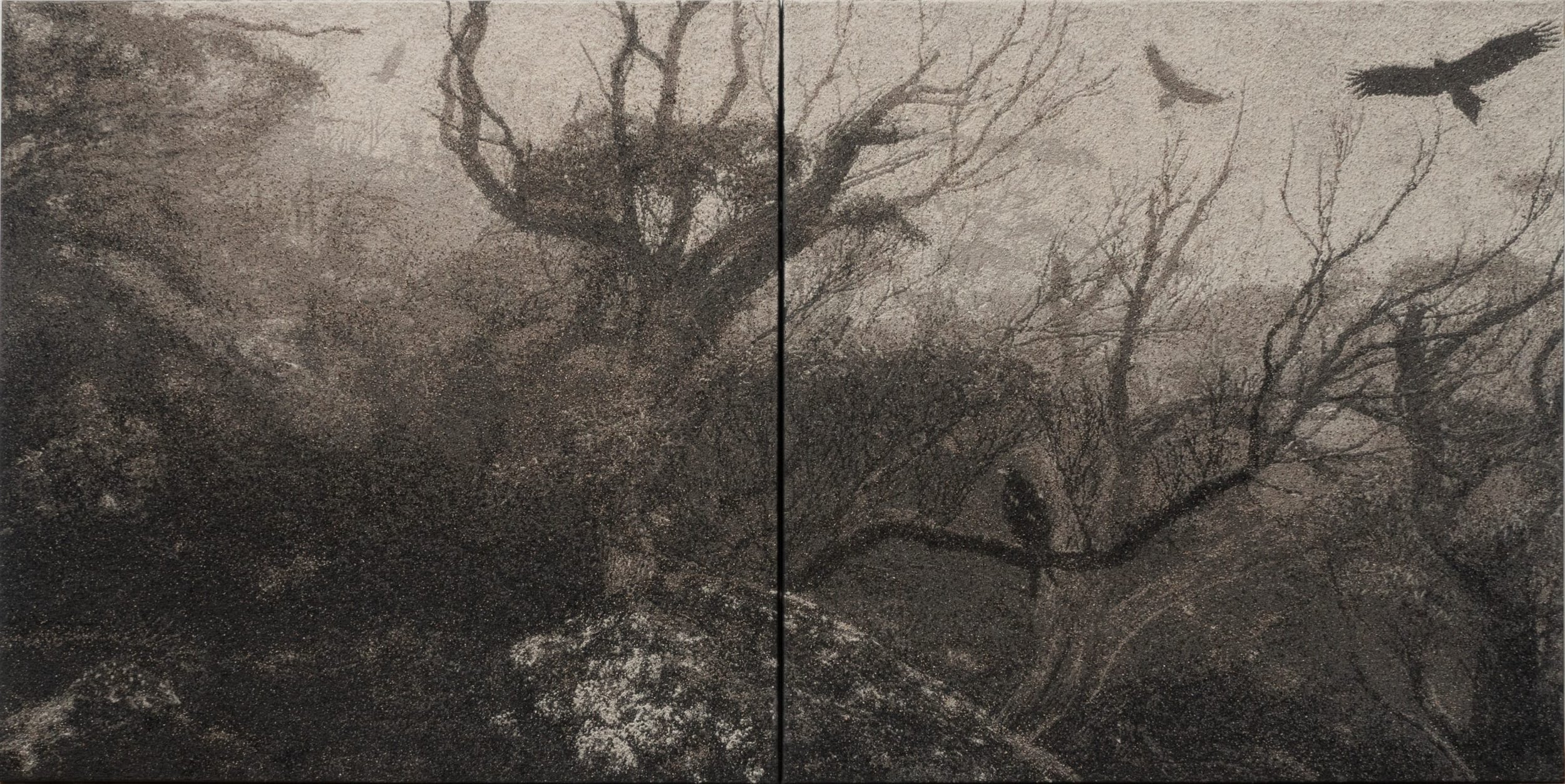
When the Eagles Soar IV
When the Eagles Soar IV, 2022, ash and polymer on marine ply, 91 x 184cm (2 panels)
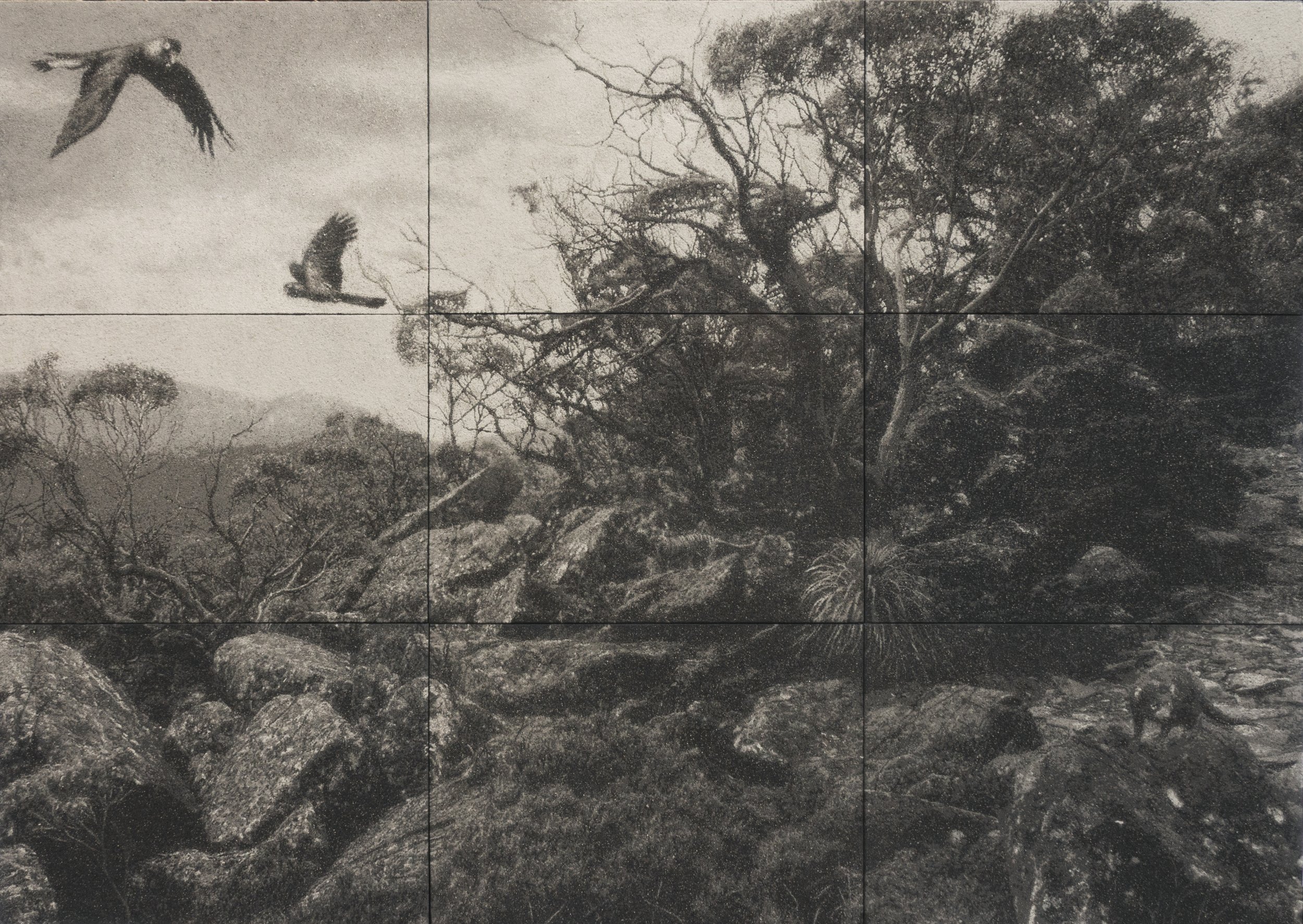
The Call
The Call, 2022, ash and polymer on marine ply, 150 x 210cm
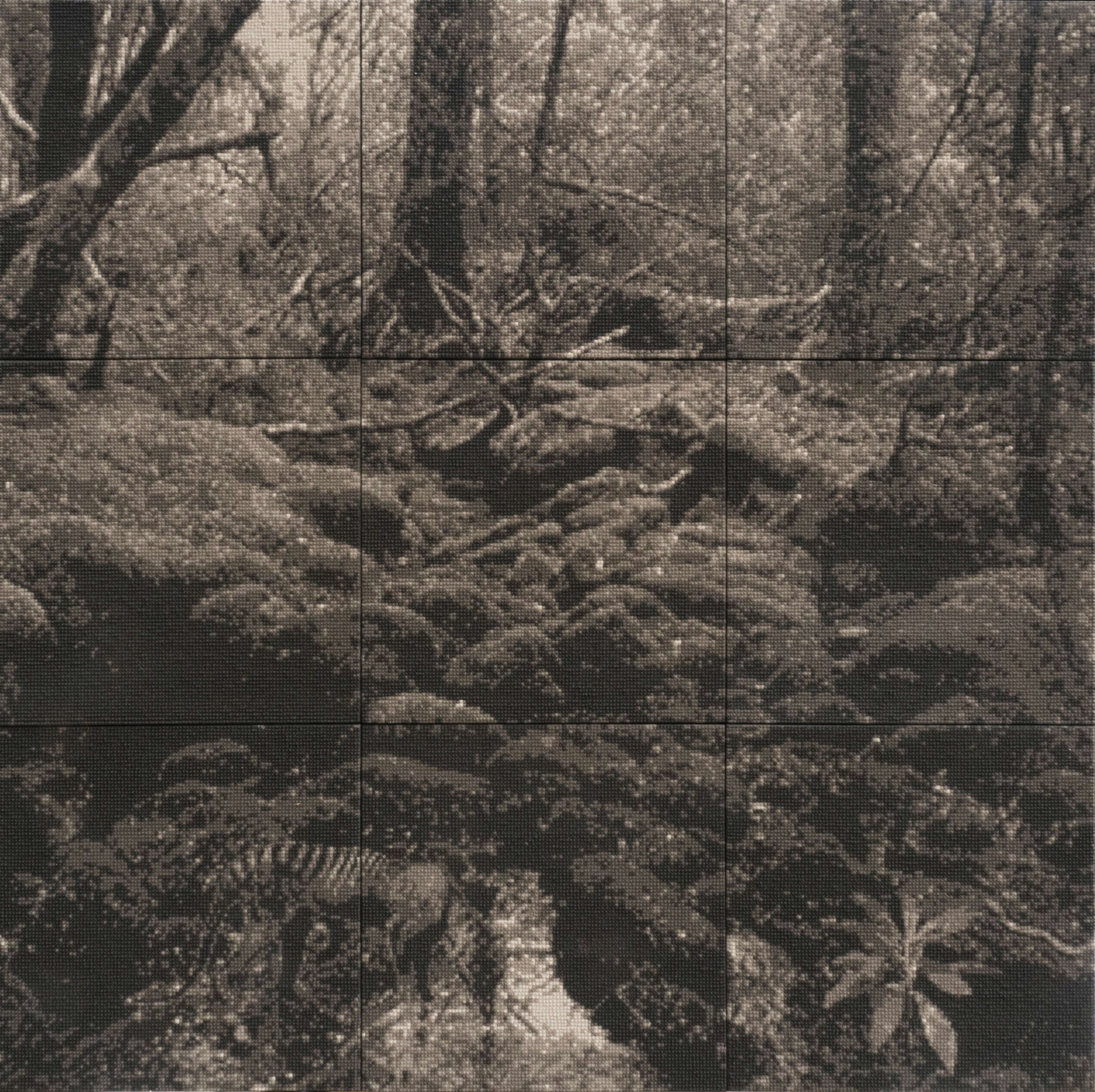
Echoes from the Forest
Echoes from the Forest, 2022, ash and polymer on marine ply, 158 x 158cm

Understory - Ash and polymer on nine individual ply panels 1500mm x 1780mm
Understory depicts a rain forest in the Lake St. Clair National Park. This subject was chosen because of the way it addresses the fragility of survival. The surface of the work, constructed out of the charred remnants of destructive fires around Tasmania speaks about the landscape’s innate vulnerability and its uneasy future. Despite the existing systems in place for protecting the natural environment, these remote and ancient landscapes are not protected from changes in our climate. At a distance we can admire the environment’s beauty, but it is not until we are close that we can truly appreciate its vulnerability.

Forest Body 2018 153cm x 240cm
To ponder A Forest Body, 2018 is to feel saturated and enveloped by the quiet depth, and simultaneous vulnerability and resilience of the Australian bush. The velvety black rendering of a surviving and spurning bush-scape is at once elusive and concrete. From certain viewpoints the intricacy and robustness of this work is fugitive and from others utterly abundant.
Sold to Art Gallery of Western Australia
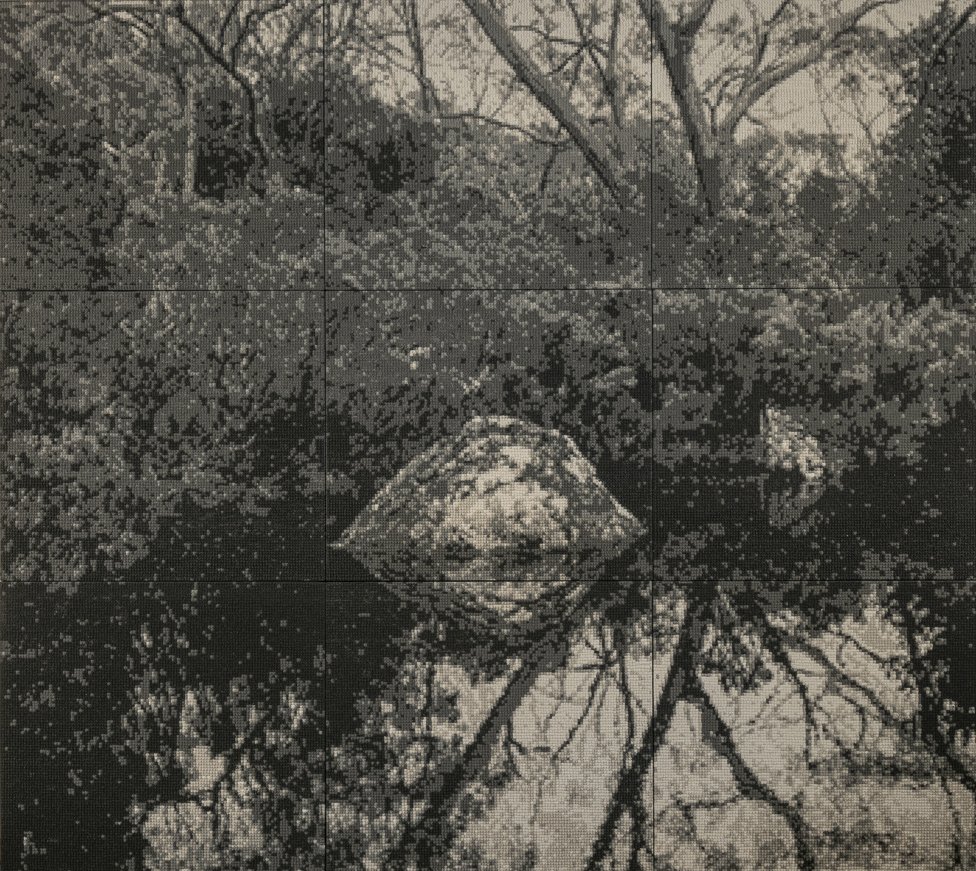
Twisted Tarn 2018 165cm X 178cm
This image is created from small pyramids of ash that have been collected from burns around the State. When you view this image from a distance it almost looks photographic but as you move closer to investigate the detail, this detail disappears until, up close, you are confronted with a digitised abstraction in burnt ash. The result is in some way a metaphor for the disappearing landscape.
Sold to Holmes a Court Collection

Yield "Study for Woven" - ash and polymer on nine canvas panels 2014
Yield and Woven were both informed by a walk through a rainforest on Mount Barrow, and the destruction caused by fire in Dunalley.
For these images I collected ash from many areas, including Dunalley. We look at the rainforest in awe, but it has also become symbolic of environmental concerns in Tasmania. There are of course inevitable natural changes that occur, but by including the Thylacine I also want to consider the ways in which human intervention causes forced processes of destruction. Yield is rendered in five tones of ash which is applied in a way which achieves a more even surfaced effect than Woven which was applied as pixels. (Woven won the Glover Prize in 2015)
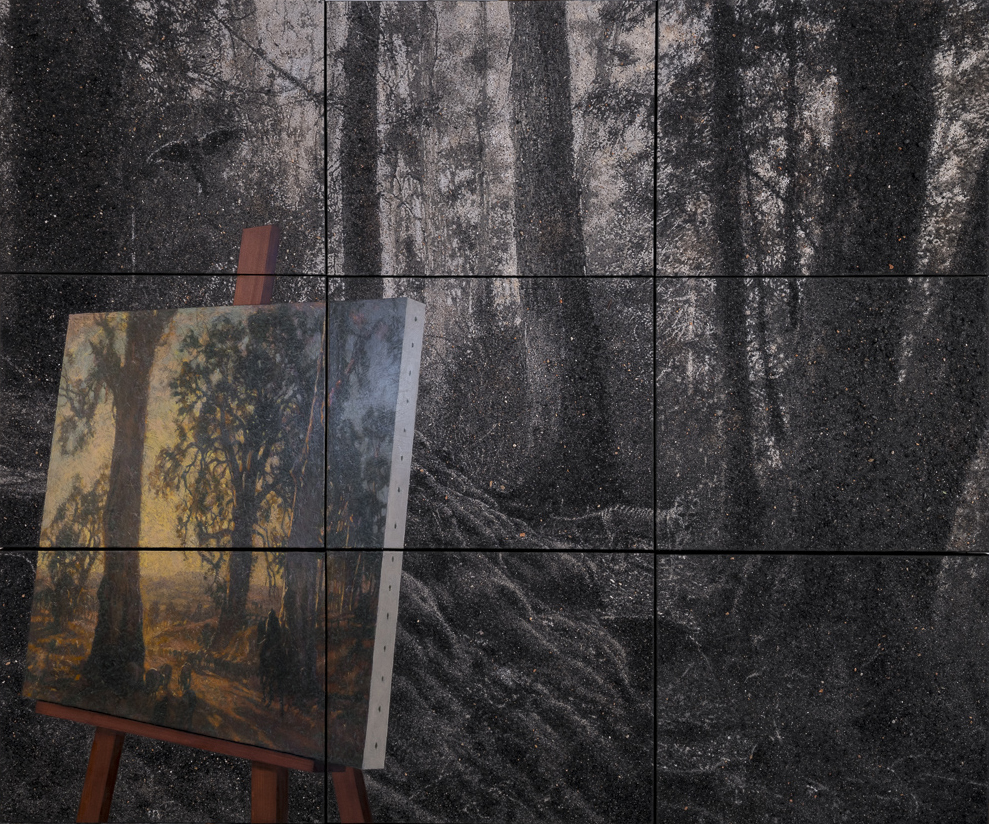
Cross-cutting - 2018 - ash, polymer, oils, wax, timber veneer on 9 canvas panels
Cross-cutting
In this work I contrast Hans Heysen’s Droving into the Light (1914-22) with an ash landscape at Lake Saint Claire in Tasmania.
The easel in the foreground calls up the presence of two artists – Heysen and myself – both of whom are implicated in the landscapes represented. Each canvas is reflective of the artist’s time and the ways in which the Australian landscape is valued and understood. For Heysen, painting in the early twentieth century in the newly formed Commonwealth of Australia, the landscape was idealised and romanticised for its great agricultural and social potential. One hundred years later, I am representing landscapes under threat.
The surface of the ash landscape, littered with charred remnants of the 2016 Tarkine fires, speaks about the subject’s innate vulnerability and its uneasy future. In our contemporary relationship with landscape we face a dilemma, needing to choose between preservation and production, while understanding the impacts the last century has had on the natural world.
Both images depict a pathway leading into evening light, Heysen’s is a celebration of the potential of a new day and an ideal future. While the ash image reflects the close of day and the fast approaching night.

Untitled (Snowgums, Mount Field) - ash and polymer on 9 canvases 183cm X 240cm (2016)
This particular work has been constructed from wood ash remnants collected from fires that were burning in the Tarkine region of Tasmania at the beginning of 2016.
This subject was chosen for this particular work because of the way it speaks about the fragility of survival. When walking through this landscape you are extremely aware of the fact that this extraordinary landscape is made up of life on the brink. There is an equal part dead as there is alive.

Reformation - ash, polymer and oil on 9 canvases 187cm X 187cm
This work was selected for the 2017 Glover Prize.
There is a finality about fire and for this reason I have used the medium ash to speak about my concerns regarding the fragility of our environment. In early 2016 during a visit to the Tarkine region of Tasmania, I was confronted by the devastation of the fires that had swept through the area after a very dry season which destroyed large tracts of temperate rain forest taking with it a unique alpine ecosystem of pencil and King Billy pines and large cushion plants that had lived for more than 1000 years. These fires were ignited by a number of dry thunderstorms and lighting strikes rolling over this unseasonally dry landscape that is normally drenched in water which under normal circumstances protects this fragile ecosystem.
Ash sourced from the aftermath of these fires was used in the construction of this painting image.
Sold to Edith Cowan University Collection

Ghosts of Change - Pinus Radiata - ash and polymer on 4 canvases 122cm x 182cm
This in an image of a view through a Pinus Radiata forest.
The planting of Pinus Radiata can be justified because of the way it can provide larger yields of usable timber in a shorter time span than many native species and it is therefore an important resource in creating a sustainable timber industry. But the down side is the proliferation of these forests in Tasmania which have wiped out major tracts of native forests that provide an essential habitat to indigenous fauna and flora.
Walking through these forests you become aware of the impact these introduced species have. The Tasmanian timber industry suggests that the acidic soil that is created by these trees has very little impact but when you are amongst these unnatural, soldier like lines of trunks where nothing grows beneath them, as exemplified by the silence, it seems the opposite might be true. Through the Tarkine region there are swaythes of these plantations that have replaced native forests. So in making this image I am questioning the impact they are having.
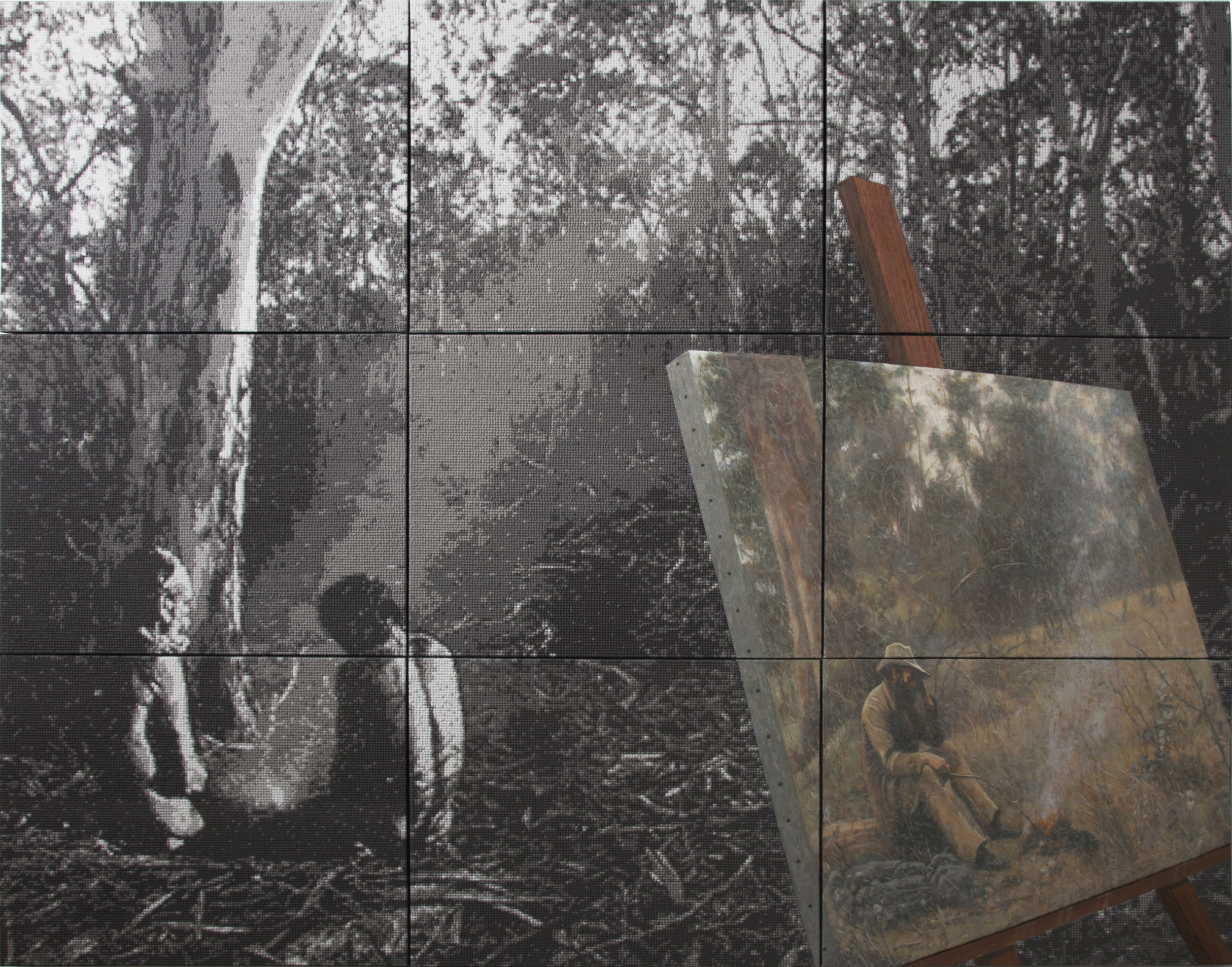
Down on their Luck - ash, wax, timber veneer, oil on 9 canvases 183cmX229cm
Painting has always been the primary medium through which I express my responses to the world. My focus involves a sense of how, for example, a landscape has arrived at the position that I am depicting. I am interested in what appears now, what the dominant thoughts are about now and what went before. What helps the depiction of this history is ironically a process of veiling which diffuses the image by removing some of the information from the subject. Over time I have used a range of mediums to create this veiling. I aim to put the known existence of my subject matter under question. The history and broader context is then revealed through the viewer’s response.
The latest incarnation of this is represented in this painting. I have setup a situation where the artist ( Frederick McCubbin) is painting a genre landscape that seems to be ignorant of its own past (a romanticised depiction). I have attempted to draw attention to this omission by depicting the landscape that is represented in the McCubbin painting and including some of the forgotten history. The veiling of this part of the subject is created by wood ash and the digital process.

Arcadia - ash, wax, timber veneer, paint brush on 9 canvases 158cm X 183cm
Arcadia contrasts John Glover’s The Ruins of the Paestum at Salerno against the Tasmanian landscape, depicted here in ash. This work by Glover was painted after his arrival in Launceston from sketches in his diaries, in which he carried his pre-exisiting notions of idealised and bucolic European landscapes to Tasmania. Through this juxtaposition Arcadia explores the problematic nature of these colonial attitudes, and how they continue to affect our approach to the natural environment today.
The Tasmanian landscape in the work is created from ash collected from an area in Glover country (near Pattadale) which had been cleared and burnt for plantation.
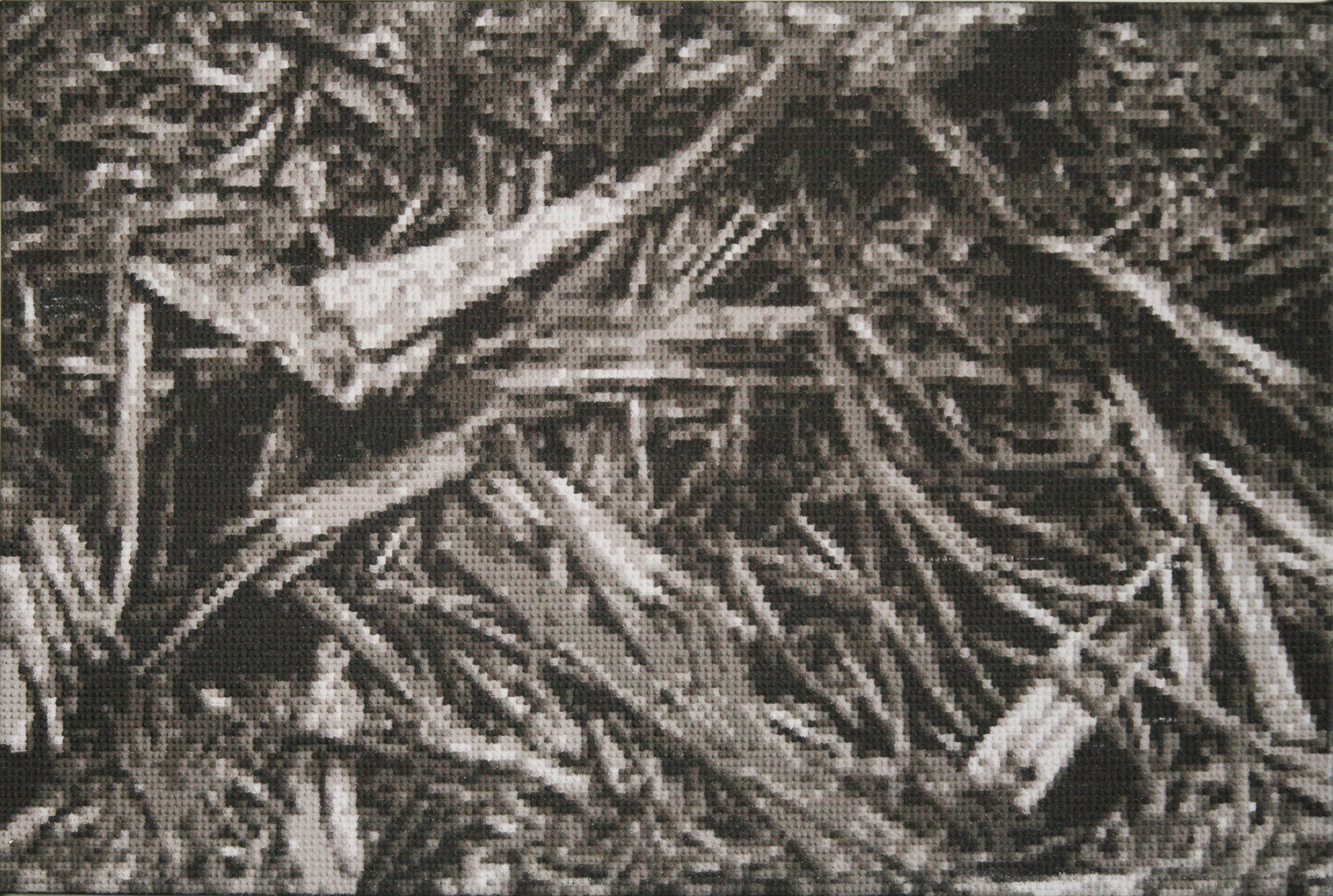
Remnants : Ash and Polymer on canvas 620mm X 920mm
This art work will be auctioned on the 15th November 2015. All proceeds will go towards supporting the important work carried out byTasmanian Conservation Trust.
www.tassieff.com/#!nigel-hewitt/c1tqr
While researching for my 2016 Creative Development Fellowship I have been investigating contested landscapes in Tasmania considering the nature of human relationships to the natural world; one of both dependence and disregard. Unsustainable forestry and logging are resulting in the loss of natural environments that are home to endangered flora and fauna.
Remnants is a result from a visit to the Styx forest in the south of Tasmania. There is an area there where in less than five metres you can walk from a pristine rain forest to an area of that rain forest that has been devastated in a way that completely disregards the precious life that existed there. My response to this was to choose an aerial view of one of the fallen trees that had been pummelled into the clay by the tracks of the bulldozers that were assisting in the clear fell.
The image is created from small pyramids of ash that has been collected from burns around the state. When you view this image from a distance it almost looks photographic but as you move closer to investigate the detail, this detail disappears until up close you are confronted with a digitised abstraction in burnt ash. The result is in some way a metaphor for the disappearing landscape.
sold private collection

In the Wake - 2015 - 150cm X94cm
Ash, wax, oils, gold leaf, polystyrene on canvas
In The Wake addresses the nature of human relationships to our environment,
Although not explicitly a landscape, this image metaphorically looks with the first nation peoples, the custodian of this land, in mind and thus entwines the image in a confusion of histories, Western and Indigenous. The flag, cast across the surface of the image, is a symbol of Western progress, which leaves in its wake confusion and the loss of an inheritance that should have been passed on with pride to future generations.
Landscape has a fraught history in Tasmania. Being a colonised land, the landscape was divided up with markers of ownership, exploiting with disregard for what it inherently has to offer, leaving in the wake a sense of great loss and a past that is etched only in the memory.

Eucalyptus regnans
Wood ash on Canvas
Eucalyptus regnans, is a species of Eucalyptus native to Tasmania and Victoria in southeastern Australia and the tallest flowering plant and one of the tallest trees in the world. A straight trunked tree with smooth grey bark and a stocking of rough brown bark to 5–20 metres (16–66 ft) above the ground, it regularly grows to 85 metres (279 ft), with the tallest living specimen, the Centurian, standing 99.6 metres (327 ft.) tall in Tasmania. The white flowers appear in autumn.

Forest Body - detail
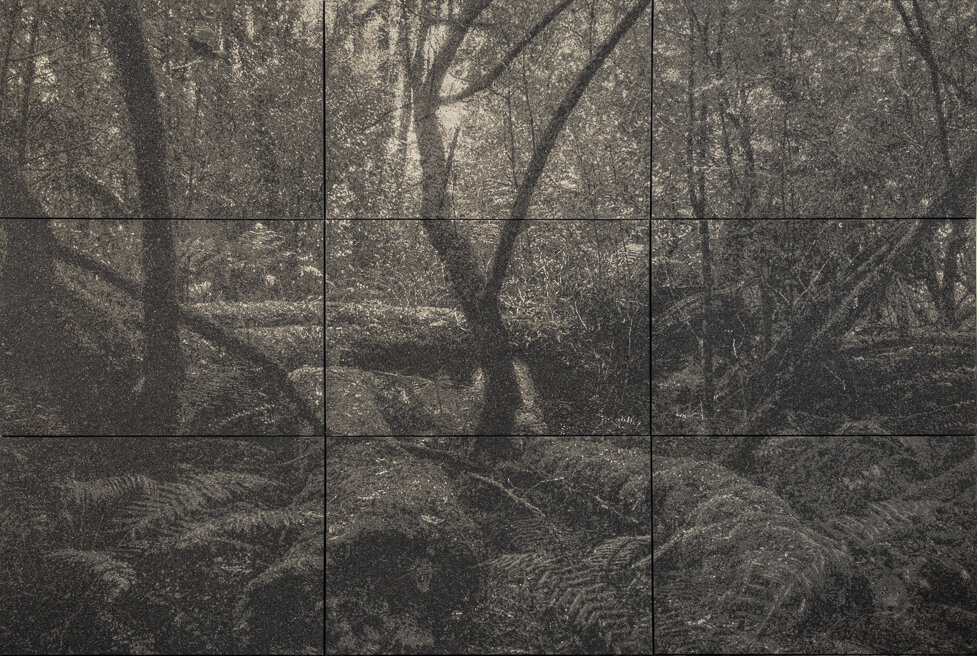

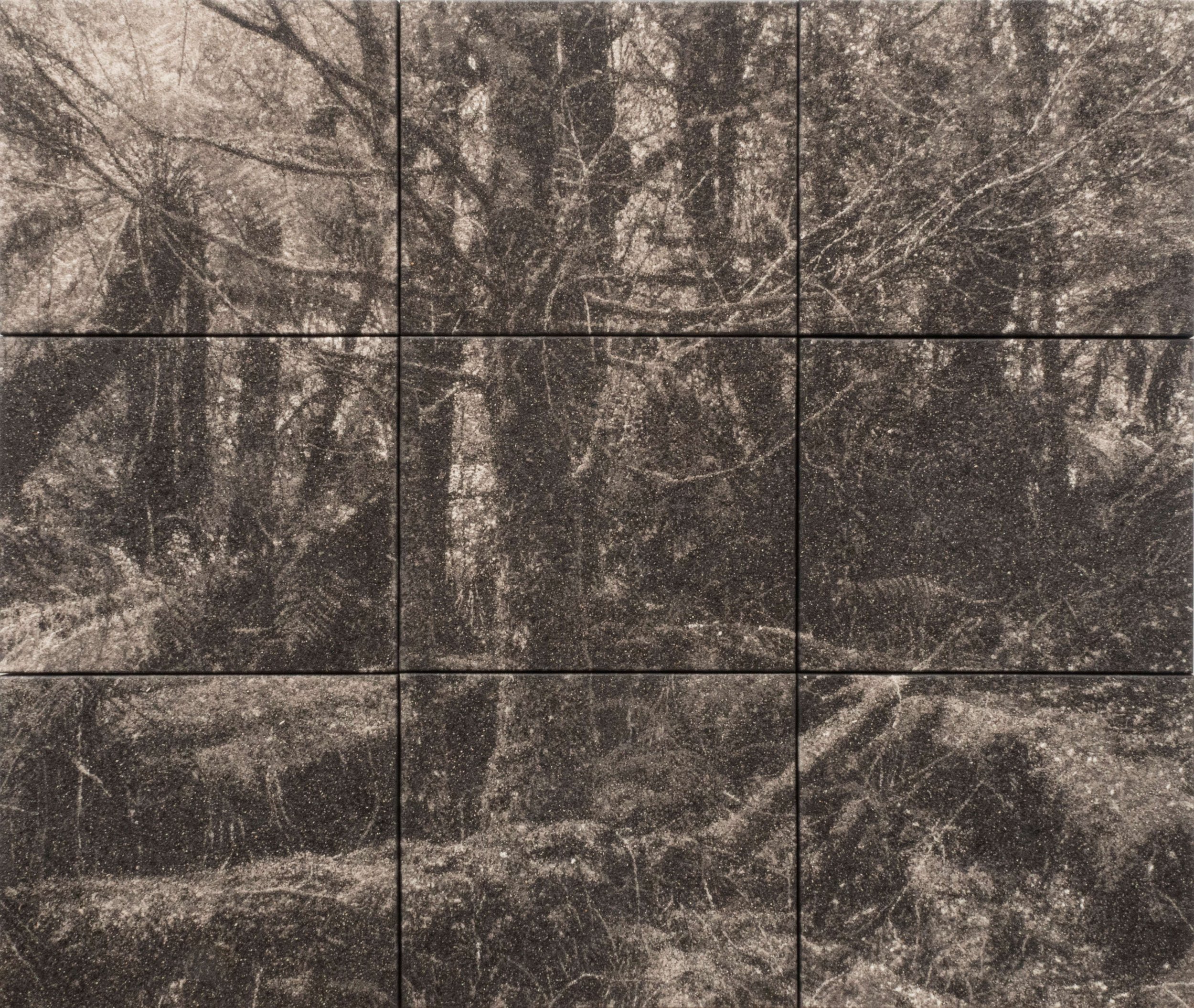
Growling Swallet
Growling Swallet, 2022, ash and polymer on timber ply, 156 x 132cm
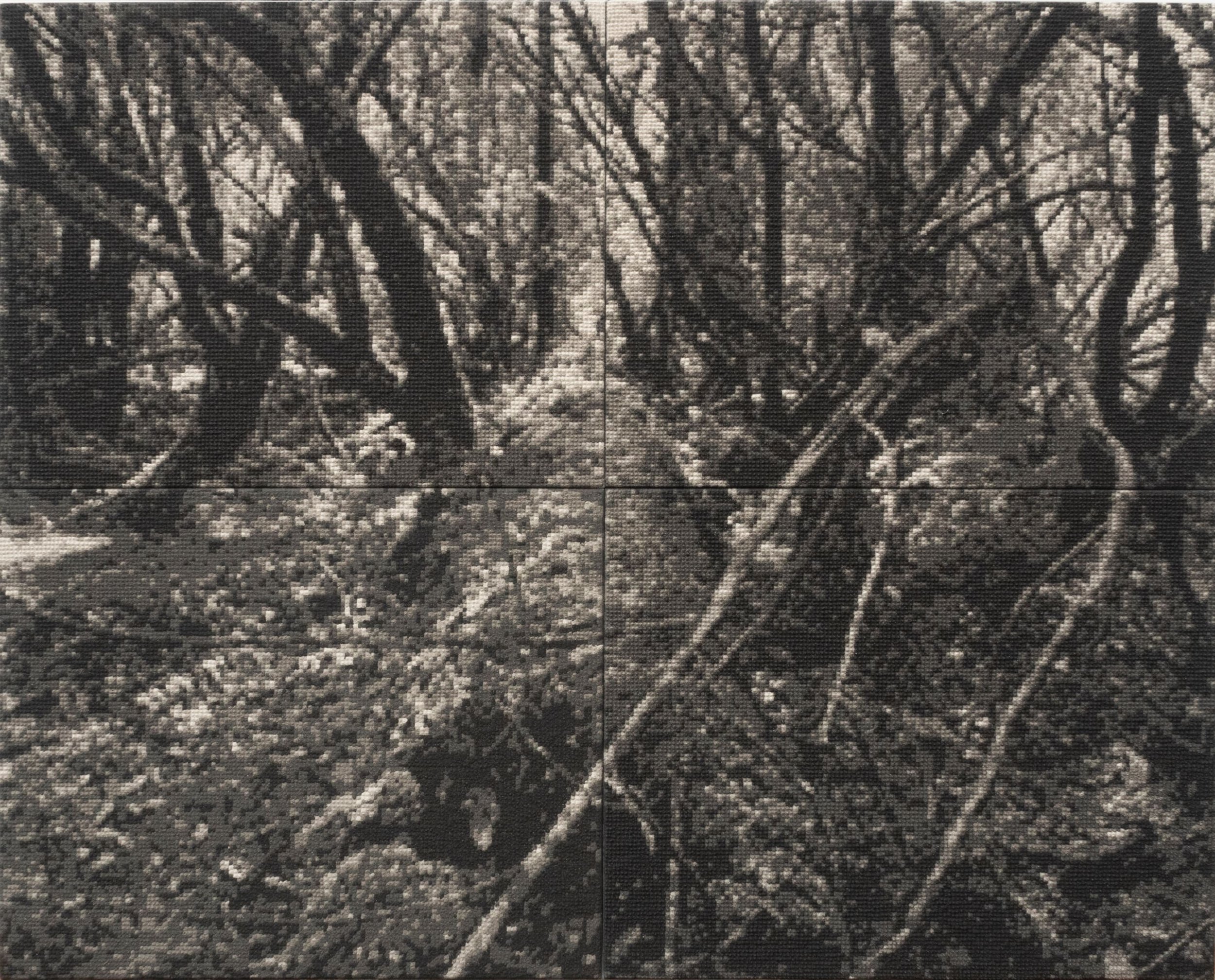
Tunnel Vision
Tunnel Vision, 2022, ash and polymer on marine ply, 120 x 150cm
Ash




















